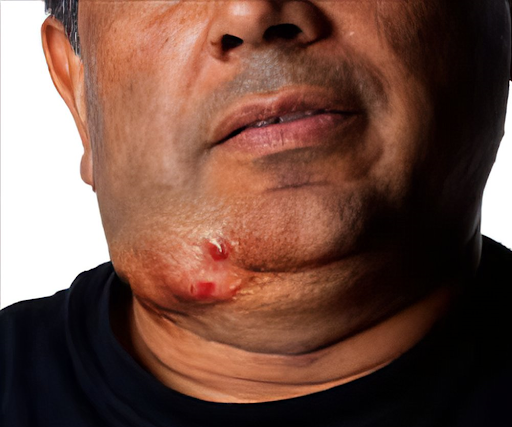ACTINOMYCOSIS
Introduction
Actinomycosis is a chronic bacterial infection caused by ‘Actinomyces’ species, which are filamentous, gram-positive bacteria. These bacteria are normally present in the mouth, digestive system, and female genital tract, but they can cause infection when the mucous membranes are broken, typically after dental surgery, abdominal injury, or in women using intrauterine devices (IUDs).
How Actinomycosis Develops:
Actinomycosis spreads slowly through tissues, forming
abscesses, sinus tracts, and sometimes discharging sulfur granules (tiny yellow
particles).
The infection can involve various areas, such as the face
(cervicofacial), chest (thoracic), or abdomen and pelvis. It can be difficult
to diagnose since it mimics other diseases, including tumors and tuberculosis.
Common Types:
1. Cervicofacial
Actinomycosis (Lumpy Jaw) :
- Most common, linked to poor dental hygiene or oral surgery.
- It leads to soft swelling in the jaw, fistulas, and pus discharge containing sulfur granules.
2. Thoracic
Actinomycosis :
- Affects the lungs, often after aspiration (inhaling bacteria from the mouth).
- Presents as a lung mass, with chest pain, cough, and sometimes sinus tracts on the chest wall.
3. Abdominal and
Pelvic Actinomycosis :
- Typically arises after surgery or trauma to the abdomen or from IUD use in women.
- May cause abdominal pain, changes in bowel habits, and a growing mass, often misdiagnosed as cancer.
Symptoms:
- Cervicofacial Actinomycosis : Jaw swelling, skin discoloration, sinus drainage, difficulty chewing.
- Thoracic Actinomycosis : Cough, chest pain, shortness of breath, weight loss, and fever.
- Abdominal Actinomycosis : Vague abdominal pain, nausea, weight loss, and a sensation of a mass in the abdomen.
- Pelvic Actinomycosis : Lower abdominal pain, abnormal vaginal bleeding or discharge.
Diagnosis:
- Diagnosing actinomycosis can be challenging, often requiring tissue samples from abscesses or sinus tracts. Sulfur granules in discharge are a key indicator.
- Imaging tests (like CT scans) may show mass-like infections, often confused with cancer.
- Laboratory tests may reveal anemia, elevated inflammatory markers, and the presence of ‘Actinomyces’ in cultures.
Treatment for Actinomycosis
Actinomycosis is primarily treated with antibiotics, and Penicillin G is the preferred drug. The treatment usually involves high doses of antibiotics for a prolonged period, ranging from 6 months to 1 year. This extended duration is necessary because actinomycosis can be slow to respond to therapy, and it may require a combination of antibiotic and surgical interventions depending on the severity of the disease.
Antibiotic Treatment:
1. Penicillin G (Pfizerpen, Bicillin) is the drug of choice (DOC) :
Initial phase: Treatment typically starts with intravenous (IV) Penicillin G, especially in severe cases. A central catheter (PICC line) may be used to administer antibiotics over weeks to months.
Oral transition: After the initial IV treatment, patients are switched to oral antibiotics, such as Penicillin VK, for the remaining course of therapy.
Duration: The total treatment duration can range from 6 to 12 months, depending on how the infection responds to therapy and the location of the disease.
2. Alternative antibiotics: In patients allergic to penicillin or where penicillin may not be effective, the following alternatives can be used:
- Doxycycline: A tetracycline antibiotic that inhibits bacterial protein synthesis. It is commonly used for patients who are allergic to penicillin but should be avoided in pregnant women.
- Clindamycin (Cleocin): Another option for penicillin-allergic patients. Clindamycin blocks bacterial protein synthesis, but it may not cover all companion bacteria that often accompany actinomyces infection.
- Amoxicillin/Clavulanic acid (Augmentin): This combination can be used in mild to moderately severe cases. It covers both the actinomyces bacteria and their companion bacteria.
- Ceftriaxone (Rocephin): A third-generation cephalosporin, useful in moderate to severe infections, especially cervicofacial and thoracic actinomycosis.
- Imipenem/Cilastatin (Primaxin): Often used in severe abdominal or pelvic infections , this combination antibiotic can target both actinomyces and other bacteria resistant to penicillin.
Surgical Treatment:
In addition to antibiotics, surgery may be necessary in certain cases. Surgery is typically reserved for:
- Draining large abscesses or sinus tracts.
- Removing infected tissue that does not respond well to antibiotics.
- Treating complications such as obstructions caused by fibrotic lesions or infections compressing vital structures (e.g., ureters)
For example, patients with abdominal actinomycosis may require emergency surgery for conditions like peritonitis or bowel perforation. Similarly, surgery may be needed to decompress infections in closed spaces, such as within the thoracic cavity or near the brain.
Monitoring During Treatment:
Since treatment can last several months, regular follow-up with imaging studies like CT scans or MRI is essential to monitor the response to therapy. Blood tests may also help track the patient’s recovery and watch for side effects. In some cases, especially when using intravenous antibiotics, a PICC line may be inserted to facilitate prolonged antibiotic administration at home.
Other Considerations :
If Penicillin G therapy fails, it could be due to companion
bacteria that resist penicillin. In such cases, the antibiotic regimen might
need to be broadened to include drugs that target these other bacteria.
Companion bacteria (such as Peptostreptococcus,
Fusobacterium, or Prevotella species) often contribute to the infection and may
require a tailored approach with additional antibiotics.
In summary, the treatment of actinomycosis is centered around prolonged, high-dose antibiotic therapy, often starting with IV penicillin and transitioning to oral antibiotics for several months. In more serious or complex cases, surgery might be needed to remove infected tissue or drain abscesses that don’t heal with antibiotics alone. Close monitoring with imaging and adjustments in the antibiotic regimen may be required to ensure the infection is fully controlled.
Prevention:
- Good oral hygiene and regular dental care are essential, especially after oral surgery.
- Women using IUDs should be aware of the increased risk of pelvic actinomycosis.
Complications:
If untreated, actinomycosis can lead to serious complications, such as bone infections, brain abscesses, and endocarditis (heart infection).
By recognizing early symptoms and following through with prolonged antibiotic treatment, most patients recover well.









No comments:
Post a Comment